Highlights
What are the main findings?
- Additional thermal stabilization, discontinuously included in the fiber preparation, was applied in various ways to PLA fibers to improve their properties for textile applications. We monitored changes in mechanical and thermomechanical properties as well as thermal behavior;
- Under the monitored stabilization conditions, shrinkage was reduced, especially at higher stabilized temperatures above 85 °C.
What is the implication of the main finding?
- Stabilization conditions influenced the results achieved, both the stabilization medium and the stabilization temperature. Therefore, their selection depends on the potential use of PLA fibers;
- The stabilization in the air under strain showed the smallest dimensional deformation;
- The thermal stabilization of PLA fibers can improve the next process of textile processing as knitting and weaving.
Abstract
In this work, we investigated the influence of stabilization on polylactic acid (PLA) fibers. Biodegradable plastics have a significantly lower environmental impact because they are produced from renewable resources and can break down through the action of microorganisms. Considering the issues of polymer waste production and accumulation, PLA, being a biodegradable material derived from renewable sources, represents a promising solution for the future. Nowadays, several studies on PLA evaluate its properties for various applications. However, we focused on improving the user properties of PLA fibers. Different thermal stabilization processes simulate the use of PLA fibers and their impact on the behavior and properties of PLA fibers exposed to these conditions. The thermal behavior of PLA fibers (the melting temperatures, the crystallization temperatures, and enthalpies), mechanical (tenacity and elongation at the break, Young’s modulus), and thermomechanical (the shrinkage and the temperature of first distortion) properties of PLA fibers have been investigated in detail. Our research results show that the PLA fibers can achieve better properties (as mechanical and dimensional) by stabilization. It is about the dimensional stability of the fibers for applications such as knitting and weaving. Under the monitored stabilization conditions, shrinkage was reduced (especially at higher stabilized temperatures above 85 °C), which can improve the next process of textile processing (knitting and weaving). Thermal stabilization after drawing is one possibility. The stabilization conditions will depend on the potential use of the PLA fibers.
1. Introduction
Developments in the field of polymers and thus also fibers and textiles are coming with biodegradable and biocompatible polymers, under the pressure of social issues related to ecology and waste generation. Biodegradable polymers are the solution due to these biopolymers decompose into low molecular weight products—carbon dioxide, water, and/or methane and biomass by the biological activity of microorganisms. Even if some biopolymers are degradable primarily in industrial waste, under precisely defined conditions, we can still talk about biodegradation because the polymer breaks down into low molecular weight products. Biodegradable polymers could be at least a partial replacement for synthetic fibers produced in large quantities worldwide [1,2,3,4,5].
Polylactic acid (PLA) is a polymer produced by chemical synthesis from monomers derived from renewable sources. PLA belongs to the group of aliphatic polyesters, which are prepared from lactic acid. Lactic acid is obtained by the fermentation of carbohydrates, which is the preferred preparation, or chemical synthesis [6]. It is the simplest hydroxyl acid with a chiral carbon, because of which it is classified as an optically active substance, and of course, its polymer also shows optical activity. PLA is found in three isomeric states—L-PLA, D-PLA, and L-D-PLA (Figure 1) [7].
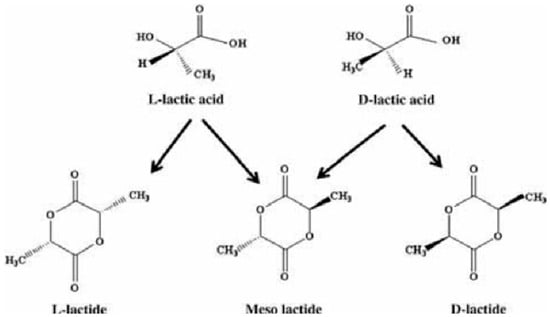
Figure 1.
Stereoforms of lactides [8].
The most comparable work to ours was performed by scientists Mezghani and Spruiell, who prepared PLA filaments from melt. Poly(L-lactic acid) filaments were prepared by high-speed melt spinning at take-up velocities up to 5000 m/min. Crystallinity, birefringence, tensile strength, Young’s modulus, and yield strength all exhibit maxima at take-up velocities between 2000 and 3000 m/min. The boiling water shrinkage exhibits a minimum in this range. The maximum tensile strength of the as-spun filaments was 385 MPa, and the maximum modulus was 6 GPa [9]. Gupta investigated the preparation conditions and their impact on the properties of PLA fibers. The important parameters affecting the properties of dry–jet–wet spun PLA fibers are the take-up speed, draw ratio, drawing temperature, and heat-setting temperature. He also divided his research into several follow-up articles, where he gradually addressed various preparation conditions and, subsequently, the impact on PLA fiber properties [10,11]. Maqsood M. and Langensiepen saw that spinning PLA fibers to produce fibers of textile grade is a big challenge. Therefore, they focused their research on preparing PLA composite fibers [12]. Using polymer fibers for various applications requires certain properties, such as tenacity and abrasion resistance, but also coloristic properties and color fastness [10,13,14,15,16]. Fibers prepared from biodegradable polymers often do not satisfy the required properties. Therefore, there is an effort to modify the manufacturing process of fiber production. Someone modifies all the mass of the polymer by adding special additives, for example, plasticizers, dyes, or pigments. In practice, composite materials are used or mixtures with various substances, which improve specific properties and become more effective from the application point of view [17,18,19,20,21,22,23,24,25]. Chang Lim Jun’s study discusses the preparation of blends of PLA together with starch and the addition of a reactive agent, where they evaluated the mechanical properties of the prepared mixtures. The polymeric blends achieved a tensile strength of 1000–1400 N/cm2 and elongation of about 40–80% [24]. Penning, Dijkstra, and Pennings prepared absorbable fibers from L-lactide copolymers. They followed mainly mechanical properties in connection with the preparation process and the subsequent impact on the amorphous and crystalline proportion of polymers/copolymers in the fiber [26]. Nazari and Garmabi studied the behavior of PLA/PEG blends during electrospinning. The effects of processing conditions on the morphology of PLA/PEG were studied [23]. Tábi, Ageyeva, and Konacs observed the crystallization kinetics and mechanical properties of PLA but used various nucleating agents and plasticizers to improve the properties. Tensile strength was from 44 to 68 MPa [17]. However, the second opportunity is to change the properties of PLA fibers by changing the conditions of their preparation [18,27,28,29,30]. But if someone solved the changes in the preparation conditions of PLA fibers, they also achieved improvement by adding nucleating agents or plasticizers. We found a few studies that exclusively focused on monitoring the change in fiber properties due to different stabilization conditions. Interesting results from this area have Cicero, who also investigated the effect of stabilization of PLA fibers in water, but from the point of view of different draw ratios, respectively, percentage of crystallinity [31]. Finally, I would like to point out that different research groups focus on the preparation of fibers and the evaluation of their properties; however, not only are the materials chosen differently, but also the methods of the spinning process [32].
It is an effort to improve fiber properties by increasing crystalline proportion in the fibers. That is why we focused on creating the crystalline structure of the fibers. The first step is to prepare PLA fibers, the melt is forced through a nozzle with holes in the spinning head. Crystallization follows due to air cooling. The crystallization rate depends on the temperature. However, crystallization is also affected by secondary fiber formation processes, namely drawing and stabilization conditions. Stabilization can be different, the fibers can be stabilized under strain or without strain, at various temperatures as well as in different mediums—air, and water. (Figure 2) Unidirectional deformation in the preparation of fibers affects the completed orientation, super-molecular and morphological structure, which determine properties mainly, such as mechanical (tenacity and elongation at the break and Young’s modulus), optical, etc.

Figure 2.
Schema of stabilization processes of PLA fibers.
In the literature, several groups present the study of PLA fibers from different points of view. However, this work aims to publish the effect of various stabilization simulated laboratory processes on the properties of PLA fibers, mainly from the point of view of the dimensional stability of PLA fibers for further use in applications such as knitting and weaving, which need determined strength, elongation, and dimensional stability. We also evaluated changes in mechanical properties as well as the effect of stabilization on the internal crystalline structure of these stabilized fibers.
2. Materials and Methods
2.1. Materials and Preparation of Polylactic Acid Fibers
The virgin poly-(lactic) acid INGEOTM Biopolymer 6202D (PLA, produced by NatureWorks LLC., Minnetonka, MN, USA) with the MFI = 15–30 g/10 min at 210 °C was used for the preparation of PLA fibers. The PLA was spun using a discontinuous laboratory line (Spinning line, VUCHV a.s., Svit, Slovakia) with a single screw extruder having a ratio screw of L/D = 30, a spinning nozzle of 13 holes, at the spinning temperature of 190 °C and final spinning process speed of 250 m.min−1, and there were prepared the undrawn PLA fibers. The undrawn fibers were drawn on the drawing ratio λ = 1.75 at a drawing temperature of 70 °C.
2.2. Process of Stabilization of PLA Fibers
The prepared PLA filaments were stabilized under different conditions. One stabilization was performed by putting the fibers in an air-drying oven, where they were exposed to an elevated temperature, but the medium was only the hot air. The first case was that the fibers were under strain 0.0018 cN.tex−1. This strain was determined based on the tenacity percentage of the monitored samples. The second case was that the fibers were stored loosely in the air-drying oven on the stabilization, so they were without strain.
Thereby, the prepared PLA fibers were stabilized at the stabilization temperatures 45, 55, 65, 85, 90, and 95 °C for 3 min in the air-drying oven. After 3 min, the PLA fibers were taken out from the air-drying oven. The stabilization temperatures were determined so that the effect of stabilization was monitored below the glass transition temperature Tg (45 °C), about Tg (55 and 65 °C), and above Tg (85, 90, and 95 °C) and so that the temperatures corresponded to the washing temperatures for the potential consumer. After the stabilization process, the dimension of PLA fibers was changed, and shrinkage (%) was estimated according to the following equation:
where L is the original length before stabilization, and L1 is the length after stabilization.
The second stabilization was performed in water as the second medium, where the 20 cm sections of PLA fibers were placed and exposed to certain bath temperatures.
For the stabilization process in the water, the PLA fibers were marked with 20 cm sections (L). Thereafter, these PLA fibers were embedded in the water with a set temperature of 45, 55, 65, 85, 90, and 95 °C for 3 min. After 3 min, the PLA fibers were picked up from the water and dried. Afterward, their length (L1) was measured, and the shrinkage was calculated for all stabilized PLA fibers according to Equation (1).
2.3. Methods
2.3.1. Differential Scanning Calorimetric
Differential scanning calorimetric (DSC) measurement was evaluated by DSC 1/700 STAReSystem software 16.40 and DSC 1/750 equipment from Mettler Toledo (Greifensee, Switzerland). Non-isothermal analysis of evaluated PLA fibers was performed and was used for the evaluation of the thermal properties of non-stabilized and stabilized PLA fibers. So, the fibers were evaluated before and after the stabilization process.
The samples of PLA were isothermally held for 3 min at 30 °C and next heated at a rate of 10 °C.min−1 from 30 °C to 200 °C. All measurements were carried out in a nitrogen atmosphere. There was measured only 1st heating to the determined structure of PLA fibers obtained during the spinning and drawing and/or changed during the stabilization processes. From melting endotherms of 1st heating the glass temperature (Tg), relaxation enthalpy (ΔHent), temperature (Tcc1), and enthalpy (ΔHcc1) of the first cool crystallization, temperature (Tcc2), and enthalpy (ΔHcc2) of the second cool crystallization, total enthalpy (ΔHcc) of cool crystallization, melting temperatures (Tm), and melting enthalpies (ΔHm) were determined.
2.3.2. Mechanical Properties
The mechanical properties are represented by tenacity at the break (σ), elongation at the break (ε), and Young’s modulus (EY). The mechanical properties of non-stabilized and stabilized PLA fibers were measured by using Instron 3343 equipment (Norwood, MA, USA). Measuring conditions were the length of fiber 125 mm and clamping rate of 500 mm.min−1. An average of at least 10 individual measurements was used for the determination of the mechanical properties of each fiber. The mechanical characteristics (tenacity at the break, Young’s modulus, and elongation at the break) were determined by Standard ISO 2062:1993.
2.3.3. Thermomechanical Properties
Thermomechanical characteristics of non-stabilized and stabilized PLA fibers were measured by equipment Shimadzu TMA-50 (Kioto, Japan). The dimensional stability (deformation—l1 and l2, %) and the temperature of the first distortion (TD1, °C) of the PLA fibers were measured. The conditions of measurement were as follows: in the temperature range, the temperature increased from room temperature to 110 °C at the heating rate of 5 °C.min−1, and the fiber length was 9.8 mm at a constant load. The dependence of the dimensional stability of fiber on the temperature was obtained, from which the thermomechanical characteristics were determined. For demonstration, Figure 3 illustrates the measured dependence of the dimensional stability of the fiber on temperature. From this, the thermomechanical characteristics were determined.
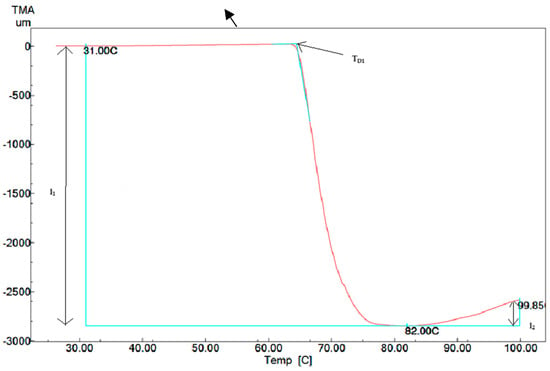
Figure 3.
Dependence of the dimensional stability of non-stabilized PLA fiber on temperature obtained by TMA analysis—TMA measurement record for clarification of the measured values.
3. Results and Discussion
3.1. Differential Scanning Calorimetric Measurements
The super-molecular parameters in the fiber can be evaluated based on differential scanning calorimetric measurements (DSC). The obtained dependences of heat flow on the temperature were used for the determination of the temperature and enthalpy of the first cool crystallization (Tcc1, ΔHcc1), temperature, and enthalpy of the second cool crystallization (Tcc2, ΔHcc2), melting temperature and enthalpy (Tm, ΔHm), glass temperature and relaxation enthalpy (Tg, ΔHent), and total enthalpies (ΔHcc). For the first heating, the thermal history of the preparation of PLA fibers was followed. The results from the endo- and exotherms phenomena used for the evaluation of fibers show the relationships with the history of preparation (treatment temperature, deformation of preparation fibers, and medium of stabilization).
Melting is a first-order phase transition when three-dimensional crystals happen isotropic melt. The melting temperature is given as an endothermic peak—the highest temperature point of the melting endotherm. The glass transition temperature is defined as the inflection point in the heat capacity change. The obtained dependent heat flow from the temperature was used to determine the temperature and enthalpy of melting and crystallization. Melting enthalpy tells us about the creation of crystalline structures of PLA in the fibers, which were formed in the process of unidirectional deformation and also during stabilizations. The share of the crystalline phase—crystallinity, is one of the basic parameters of the super-molecular structure, which has an impact on other properties of the prepared fibers from the point of view of application possibilities.
Cold crystallization is a process where a polymer’s sample crystallizes or recrystallizes during the heating; it takes place from glass transition temperature to melting temperature. However, it happens closer to the glass transition temperature than the melting temperature.
For DSC measurement, we selected only three stabilization temperatures from each type of stabilization for the presentation. They are the samples that best present the properties of stabilized PLA fibers. An overview of these selected samples is presented in Table 1. These sample numbers correspond to the numbers in the thermograms.

Table 1.
The prepared samples that presented DSC measurements.
DSC thermograms of PLA samples are shown in Figure 4, Figure 5, Figure 6 and Figure 7. Figure 4 shows a thermogram of PLA fiber, which was non-stabilized as a reference sample (sample 0). Figure 5, Figure 6 and Figure 7 represent PLA fibers that have been stabilized under various conditions (samples 1–9). They show that progress is very similar. However, it is possible to monitor changes due to different stabilizations. These thermograms are from the first heating of PLA fibers’ samples; therefore, they carry information about the effect of processing preparation on the PLA fibers.
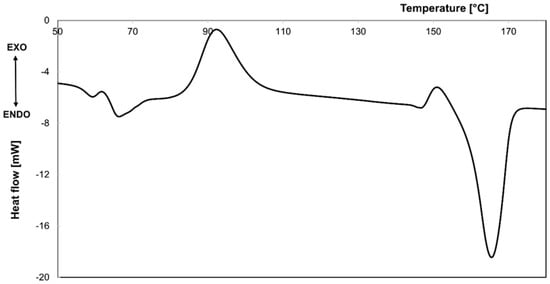
Figure 4.
DSC thermogram obtained from first heating of non-stabilized (sample 0) PLA fiber.
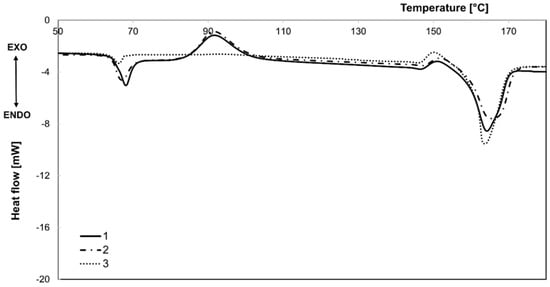
Figure 5.
DSC thermograms obtained from the first heating of PLA fibers—stabilized in hot air without strain, where there is a difference in temperatures of stabilization 45 °C (curve 1), 65 °C (curve 2), 90 °C (curve 3).
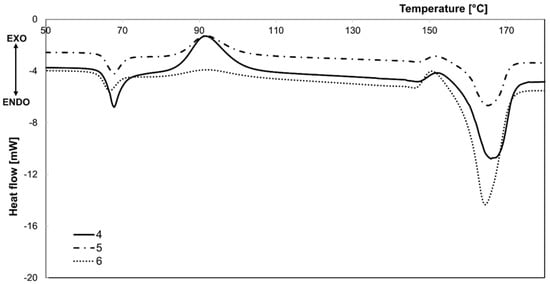
Figure 6.
DSC thermograms obtained from the first heating of PLA fibers—stabilized in hot air with strain, where there is a difference in temperatures of stabilization 45 °C (curve 4), 65 °C (curve 5), and 90 °C (curve 6).
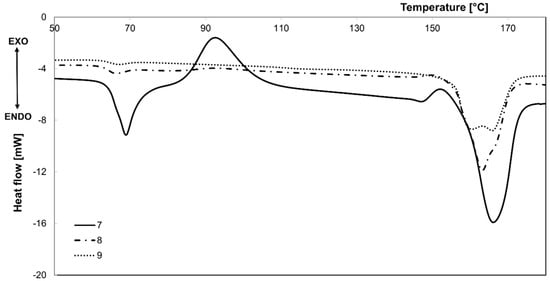
Figure 7.
DSC thermograms obtained from the first heating of PLA fibers—stabilized in water, where there is a difference in temperatures of stabilization 45 °C (curve 7), 65 °C (curve 8), and 90 °C (curve 9).
The effect of stabilization on the glass transition temperature can be observed mainly with the stabilization temperature changes. Different stabilizations led to an increase in the glass transition temperature compared to untreated fiber. The largest increase occurred at the stabilization temperature of 45 °C from 66 to 68–69 °C (Figure 8a). A higher content of the crystalline phase after stabilization leads to an increase in the glass transition temperature due to less mobility of the chains. This is manifested by a more significant drop in the glass transition temperature at the stabilization temperature already at 65 °C, which corresponds to the relaxation enthalpy at this temperature. This manifested itself as well as a further decrease in the relaxation enthalpy in dependencies on the stabilization temperature at 90 °C from a value of almost 6 to a value of around 1 J.g−1. During stabilization in water, a significant decrease in relaxation enthalpy, about 1 J.g−1, occurred already at 65 °C temperature (Figure 8b).
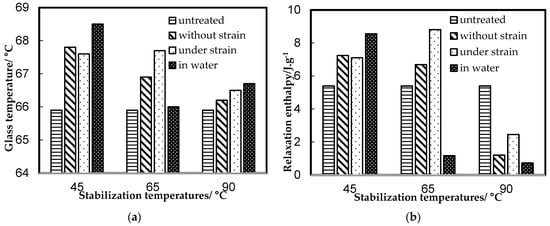
Figure 8.
Dependencies of the glass temperature (Tg) and relaxation enthalpy (ΔHent) on the stabilization temperature of PLA fibers stabilized (samples 1–9)—non-stabilized/untreated (sample 0), without and with strain/treated in hot air and stabilized in water.
As already shown in Table 2—cold crystallization temperatures and melting temperature—two cold crystallizations occurred during heating. The enthalpy values in the first cold crystallization (Figure 9a) are more pronounced compared to the second cold crystallization (Figure 9b). While the enthalpies of the first cold crystallization reach values from 20 to 30 J.g−1, mainly at lower stabilization temperatures, the enthalpies of the second cold crystallization reach values of around 3 J.g−1. By increasing the stabilization temperature for all types of stabilization, crystallites with higher stability might be formed (which may be related to the size or modification of the crystallite), which do not recrystallize and thus lead to the elimination of cold crystallization. The total enthalpy of cool crystallization includes the contribution of both the first and the second cold crystallization in Figure 9c.

Table 2.
Thermal properties—temperature (Tcc1) of first cool crystallization, temperature (Tcc2) of second cool crystallization, melting temperatures (Tm) of non-stabilized (sample 0), and various stabilized (samples 1–9) PLA fibers.
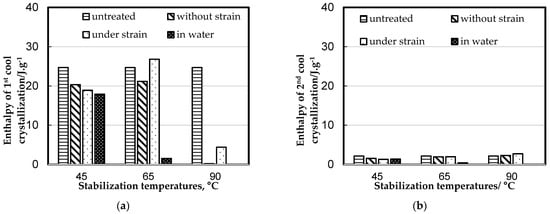
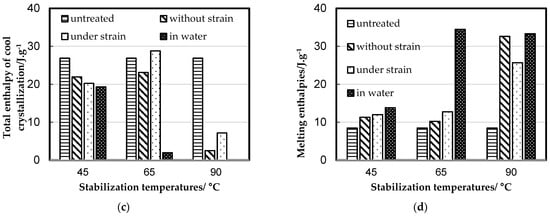
Figure 9.
Dependencies enthalpy ΔHcc1 of first cool crystallization (a), enthalpy ΔHcc2 of second cool crystallization (b), total enthalpy ΔHcc of cool crystallization (c), and melting enthalpies ΔHm (d) on the stabilization temperature of PLA fibers various stabilized (samples 1–9)—non-stabilized/untreated (sample 0), without and with strain in hot air and stabilized in water.
Again, we can compare untreated PLA fiber with different stabilization processes and different stabilization temperatures. The formation of the stable crystal structures at higher stabilization temperatures was also confirmed by observing the melting enthalpy, where we included a subtraction of the share of the enthalpy of cold crystallization. The effect of stabilization temperature on the internal structure is the most pronounced at 90 °C, where the values of melting enthalpy increased the most, from a value of approximately 9 to a value of around 30 J.g−1. This is also confirmed by previous results (Figure 9d).
3.2. Mechanical Properties
The evaluation of mechanical and thermomechanical properties was preceded by the stabilization of the fibers at different temperatures as well as under three different stabilization conditions in Figure 10. The stabilization temperatures were 45, 55, 65, 85, and 95 °C. The kinds of stabilization were with and without strain in hot air and stabilized in water. We evaluated the effect of stabilization on the dimensional stability of the fibers. Stabilization of PLA fibers caused the fibers to shrink. The fibers stabilized without strain in hot air had such a significant dimensional change that it was not possible to evaluate the mechanical properties of these fibers for technical reasons.
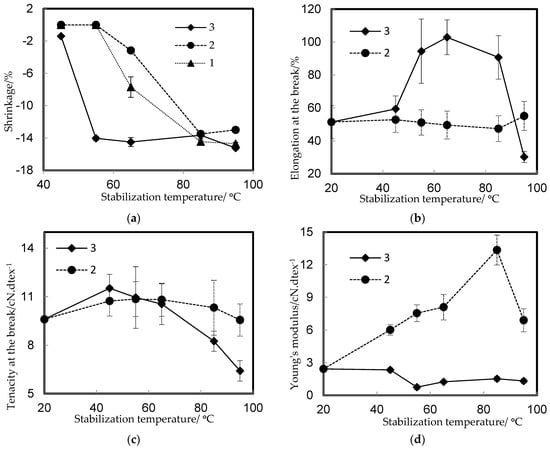
Figure 10.
Dependencies of shrinkage (a), elongation at the break (b), tenacity at the break (c), and Young’s modulus (d) on the stabilization temperature of PLA fibers, which are various stabilized—stabilized in hot air without strain (1), in the hot air with strain (2), and in water without strain (3).
The effect of stabilization on the dimensional stability of PLA fibers during the stabilization itself is in Figure 10a. During stabilization in the hot air without strain, the first shrinkage of the PLA fiber occurs at a temperature of 65 °C (shrinkage of 7.7%). As the stabilization temperature increases, the shrinkage of the PLA fiber increases up to a temperature of 85 °C, when the shrinkage stabilizes at a constant value (around 14%). When PLA fiber was stabilized under strain in hot air, the first shrinkage also occurred at 65 °C (3.2%). Increasing the stabilization temperature above 80 °C causes more significant shrinkage of the PLA fiber (up to about 13.5%), which does not change by further increasing the stabilization temperature. Larger changes in shrinkage of PLA fiber occur during stabilization without strain compared to stabilization with strain. During the stabilization of PLA fiber in water without strain, a small shrinkage occurred at a temperature of 45 °C (approx. 1.4%), and increasing the stabilization temperature to 55 °C caused the increase in shrinkage to about 14.0%, which was constant at higher stabilization temperatures.
The temperature at which the first-dimensional change in the fiber occurs depends on the stabilization conditions. Fibers under tension were stabilized in a straight position, which led to a later dimensional change compared to fibers stabilized without strain.
During the stabilization of the PLA fibers without strain in hot air, the fibers were deformed to such an extent that it was not possible to measure their mechanical properties. After the fibers had shrunk in hot air, the fiber could not be tensed and clamped to the clamping length used. Therefore, the evaluation of mechanical properties is shown in Figure 10b–d only for fibers that have been stabilized in hot air with strain and in water without strain. The effect of different stabilizations can be observed on these mechanical properties.
PLA fibers stabilized in the hot air with strain, where there was a significant effect that the fibers were stabilized with strain, tenacity, and elongation at the break changed with increasing temperature only a little, in the range of measurement error. The stabilization process did not affect the stable structure for the tenacity and elongation at the break of these fibers. The change can be seen in Young’s modulus, where the effect of stabilization with strain was manifested to increase Young’s modulus (from 3 to 13 cN.dtex−1) with increasing stabilization temperature up to 85 °C, followed by a sharp decrease, but not below the value of the non-stabilized fiber.
During stabilization in the air without strain, a different crystalline structure was formed, which manifested itself in a different course of mechanical properties. The elongation at the breakup (Figure 10b) to 45 °C was stable, but from 55 °C to 85 °C, there was an enormous increase (from 50 to 100%); at 95 °C, there was a significant decrease to below the value of the untreated fiber (the value about 40%). The tenacity at the breakup (Figure 10c) to 45 °C increased slightly, then with increasing stabilization temperature, there was a gradual decrease in tenacity. This decrease was greater from the stabilization temperature of 85 °C, below the value of the non-stabilized fiber. Despite the significant increase in the crystalline proportion after stabilization in water, the increase in elongation may be related to the increased mobility of polymer chains in the amorphous region, as a result of the release of secondary bonds at higher temperatures. This is also reflected in the results of relaxation enthalpy compared to stabilization in hot air, and on the contrary, Young’s modulus (Figure 10d) had only a constant or slightly decreased course in the range of stabilization temperatures.
During stabilization under strain, tension is relaxed in the oriented state of polymer chains or supramolecular structures. In fibers stabilized without strain, the orientation of the system may decrease and thus also significantly change in mechanical properties, which can also be observed in the results achieved.
3.3. Thermo-Mechanical Properties
After the stabilization of PLA fibers by several types of stabilization at different temperatures, we subjected these fibers to thermomechanical measurement, where we wanted to determine the temperature of the first distortion and the dimensional stability in of stabilized fibers in comparison with non-stabilized fiber (first value in dependences). In Figure 11, there are two dependencies of dimensional stability because during the TMA measurement of PLA fibers, there was shrinkage—l1 (b) (Figure 11b) and elongation—l2 (c) (Figure 11c) of the fibers (see Figure 3). Figure 3 is an example of the course of fibers’ behavior under thermomechanical load, which had a similar course for all measured fibers. On the thermomechanical dependence of PLA fibers in the observed interval from 30 to 90 °C, several transitions related to their dimensional stability were found. The fibers stabilized with all kinds of stabilizations as well as non-stabilized fibers have the same course up to the temperature of 60 °C.
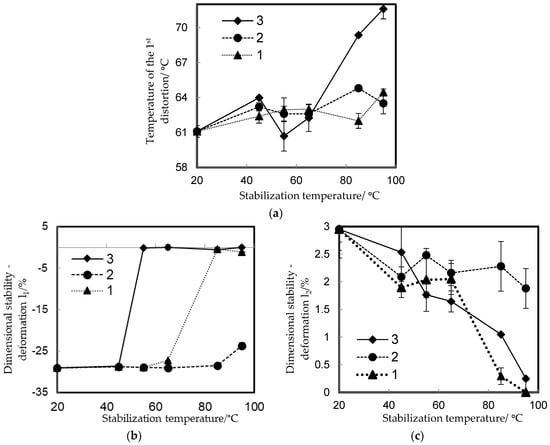
Figure 11.
Dependencies the temperature of the first distortion—TD1 (a), the dimensional stability—deformation l1 (b) and l2 (c) of the PLA fibers various stabilized—non-stabilized on stabilized temperature, which was stabilized without strain in the hot air (1) and with strain in the hot air (2) and stabilized in water without strain (3).
The dependency of the temperature of the first distortion on stabilized temperature is in Figure 11a. The first shrinkages of PLA fibers occur above the temperature of about 60 °C (61–65 °C), except for fibers stabilized in water at temperature above 85 °C (around 70 °C). At higher temperatures, the course was similar, and the values of the first distortion or the amount of shrinkage and elongation changed. The increased stabilization temperature of the PLA fibers above the glass transition temperature causes a change in the course of thermomechanical dependence.
The evaluated deformations l1 and l2, depending on the temperature and the method of stabilization, can be seen in Figure 11b,c. The largest shrinkage (28%) and elongation (2.8%) occur for non-stabilized fiber. Both shrinkage and elongation of the fibers decrease with increasing stabilization temperature. The fibers stabilized in water at a temperature above 55 °C show very little shrinkage (0.1–1.6%) and consequent elongation (up to 2.5%) of the fibers. The fibers stabilized in the hot air without strain, they achieved large and nearly constant shrinkage (around 28%) for all stabilization temperatures and also large elongation values (2–2.5%). The fibers stabilized in hot air, but with strain, they achieved minimal shrinkage and elongation (max. up to 1%) at stabilization temperatures higher than 85 °C.
The temperature at which the first-dimensional change in the fiber occurs depends on the stabilization conditions. Fibers stabilized under strain were stabilized in a straight state, which led to a later dimensional change during thermomechanical measurements. In comparison with fibers stabilized without strain, there was a significant dimensional change already during stabilization; therefore, later, there was a smaller dimensional change.
A comparison of the thermomechanical dependences of the non-stabilized PLA fiber and PLA fibers stabilized under different conditions shows that the PLA fibers need to be stabilized after drawing, and the stabilization conditions will depend on the potential use of the PLA fibers, such as weaving and knitting.
4. Conclusions
The influence of stabilization conditions on the properties of PLA fibers was studied.
Stabilizations were made in various media (air and water). Here, we would like to point out that the stabilization in air under strain showed the smallest dimensional deformation. Without strain, the value of shrinkage was comparable during stabilization in air and in water; it only differed in the temperature at which this change occurred. The other parameter studied was the stabilization temperature, which we chose concerning below, around, and above the glass transition temperature Tg and also temperatures corresponding to the washing temperatures for the potential consumer. Here, we would like to point out that there was a difference in the response of the fibers to the rise in temperature. The effect of stabilization was reflected in the enthalpy values in all kinds of stabilization depending on the increasing stabilized temperature. Different stabilizations led to an increase in the glass transition temperature compared to untreated fiber. A higher content of the crystalline phase after stabilization leads to a decrease in the glass transition temperature due to less mobility of the chains. A drop in the glass transition temperature corresponds to a decrease in the relaxation enthalpy. By increasing the stabilization temperature for all types of stabilization, crystallites with higher stability were formed, which did not recrystallize and thus led to the elimination of cold crystallization. The formation of the stable crystal structures at higher stabilization temperatures was also confirmed by observing the melting enthalpy. The effect of stabilization temperature on the internal structure is the most pronounced at the highest stabilization temperature.
These evaluations of the super-molecular structure also confirmed the mechanical and thermomechanical properties, where we could significantly perceive the difference in stabilization processes. The largest changes in mechanical and thermomechanical properties compared to non-stabilized fiber were observed for fiber stabilized in water. The need for the stabilization of PLA fibers is obvious for mainly textile use as knitting and weaving.
Author Contributions
Conceptualization, M.P. and A.U.; methodology, M.P.; software, M.P.; validation, M.P. and A.U.; formal analysis, M.P.; investigation, M.P. and J.R.; resources, M.P. and A.U.; data curation, M.P. and M.K.; writing—original draft preparation, M.P.; writing—review and editing, M.P., V.H. and A.U.; visualization, M.P.; supervision, A.U. All authors have read and agreed to the published version of the manuscript.
Funding
This research was funded by The Slovak Research and Development Agency grant number no. APVV-21-0172.
Data Availability Statement
The raw data are available on request.
Acknowledgments
The Slovak Research and Development Agency supported this work under contract no. APVV-17-0078 and APVV-21-0172.
Conflicts of Interest
Every author confirms that this manuscript has not been published/submitted in any other journal. It is only submitted in this journal. All authors have contributed to this research work and the preparation of the manuscript. Additionally, the authors have no conflicts of interest to the best of our knowledge.
References
- Plavec, R.; Hlaváčiková, S.; Omaníková, L.; Feranc, J.; Vanovčanová, Z.; Tomanová, K.; Bočkaj, J.; Kruželák, J.; Madlenová, E.; Gálisová, I.; et al. Recycling possibilities of bioplastics based on PLA/PHB blends. Polym. Test. 2020, 92, 106880. [Google Scholar] [CrossRef]
- Shah, A.A.; Hasan, F.; Hameed, A.; Ahmed, S. Biological degradation of plastics: A comprehensive review. Biotechnol. Adv. 2008, 26, 246–265. [Google Scholar] [CrossRef] [PubMed]
- Nair, L.S.; Laurencin, C.T. Biodegradable polymers as biomaterials. Prog. Polym. Sci. 2007, 32, 762–798. [Google Scholar] [CrossRef]
- Puchalski, M.; Kwolek, S.; Szparaga, G.; Chrzanowski, M. Investigation of the Influence of PLA Molecular Structure on the Crystalline Forms (α’ and α) and Mechanical Properties of Wet Spinning Fibers. Polymers 2017, 9, 18. [Google Scholar] [CrossRef]
- Rajeshkumar, G.; Arvindh Seshadri, S.; Devnani, G.L.; Sanjay, M.R.; Siengchin, S.; Prakash Maran, J.; Al-Dhabi, N.A. Environment-friendly, renewable and sustainable poly lactic acid (PLA) based natural fiber reinforced composites—A comprehensive review. J. Clean. Prod. 2021, 310, 127483. [Google Scholar] [CrossRef]
- Avérous, L. Polylactic Acid: Synthesis, Properties and Applications. In Monomers, Polymers, and Composites from Renewable Resources; Belgacem, M.N., Gandini, A., Eds.; Elsevier Science: Oxford, UK, 2008; pp. 433–450. [Google Scholar] [CrossRef]
- Tokiwa, Y.; Cololia, B.P. Biodegradability and biodegradation of poly(lactide). Appl. Microbiol. Biotechnol. 2006, 72, 244–251. [Google Scholar] [CrossRef]
- Lopes, M.S.; Jardini, A.L.; Filho, R.M. Poly (lactic acid) production for tissue engineering applications. Procedia Eng. 2012, 42, 1402–1413. [Google Scholar] [CrossRef]
- Mezghani, K.; Spruiell, J.E. High Speed Melt Spinning of Poly(L-lactic acid) Filaments. J. Polym. Sci. 1998, 36, 1005–1012. [Google Scholar] [CrossRef]
- Gupta, B.; Revagade, N.; Anjum, N.; Atthoff, B. Preparation of Poly(lactic acid) Fiber by Dry-Jet-Wet-Spinning. I. Influence of Draw Ratio on Fiber Properties. J. Appl. Polym. Sci. 2006, 100, 1239–1246. [Google Scholar] [CrossRef]
- Gupta, B.; Revagade, N.; Anjum, N.; Atthoff, B.; Hilborn, J. Preparation of Poly(lactic acid) Fiber by Dry-Jet-Wet Spinning. II. Effect of Process Parameters on Fiber Properties. J. Appl. Polym. Sci. 2006, 101, 3774–3780. [Google Scholar] [CrossRef]
- Maqsood, M.; Langensiepen, F.; Seide, G. Investigation of melt spinnability of plasticized polylactic acid biocomposites-containing intumescent flame retardant. J. Therm. Anal. Calorim. 2020, 139, 305–3018. [Google Scholar] [CrossRef]
- Liu, Q.; Sun, Y.; Xia, S. Structure and mechanical property of polylactide fibers manufactured by air drawing. Text. Res. J. 2016, 86, 948–959. [Google Scholar] [CrossRef]
- Drumright, R.E.; Gruber, P.R.; Henton, D.E. Polylactic acid Technology. Adv. Mater. 2000, 12, 1841–1846. [Google Scholar] [CrossRef]
- Adamcová, D.; Vaverková, M. Biodegradation of Degradable/Biodegradable Plastic Material in Controlled Compositing Environment. Pol. J. Environ. Stud. 2014, 23, 1465–1474. [Google Scholar]
- Kervran, M.; Vagner Ch Cochez, M.; Poncot, M.; Saeb, M.R.; Vahabi, H. Thermal degradation of polylactic acid (PLA)/polyhydroxy butyrate (PHB) blends: A systematic review. Polym. Degrad. Stab. 2022, 201, 109995. [Google Scholar] [CrossRef]
- Tábi, T.; Ageyava, T.; Kovács, J.G. The influence of nucleating agents, plasticizers, and molding conditions on the properties of injection molded PLA products. Mater. Today Commun. 2022, 32, 103936. [Google Scholar] [CrossRef]
- El-Taweel, S.H.; Al-Ahmadi, A. Non-isothermal crystallization kinetics of poly(3-hydroxybutyrate)/EVA 80 blends enhanced by NH4Cl as a nucleating agent. J. Therm. Anal. Calorim. 2019, 137, 1657–1672. [Google Scholar] [CrossRef]
- Gu, S.-Y.; Zhang, K.; Ren, J.; Zhan, H. Melt rheology of polylactide/poly(butylene adipate-co-terephthalate) blends. Carbohydr. Polym. 2008, 74, 79–85. [Google Scholar] [CrossRef]
- Bagheriasl, D.; Carreau, P.J. Shear rheology of polylactide (PLA)–cellulose nanocrystal (CNC) nanocomposites. Cellulose 2016, 23, 1885–1897. Available online: https://link.springer.com/article/10.1007/s10570-016-0914-1 (accessed on 20 January 2024). [CrossRef]
- Salehiyan, R.; Hyun, K. Effect of organoclay on non-linear rheological properties of poly(lactic acid)/poly(caprolactone) blends. Korean J. Chem. Eng. 2013, 30, 1013–1022. [Google Scholar] [CrossRef]
- Baiardo, M.; Frisoni, G.; Scandola, M.; Rimelen, M.; Lips, D.; Ruffieux, K.; Wintermantel, E. Thermal and Mechanical Properties of Plasticized poly (L-lactic acid). J. Appl. Polym. Sci. 2003, 90, 1731–1738. [Google Scholar] [CrossRef]
- Nazari, T.; Garmabi, H. The effects of processing parameters on the morphology of PLA/PEG melt electrospun fibers. Polym. Int. 2018, 67, 178–188. [Google Scholar] [CrossRef]
- Jun, C.L. Reactive Blending of Biodegradable Polymers: PLA and Starch. J. Polym. Environ. 2000, 8, 33–37. [Google Scholar] [CrossRef]
- Jiang, L.; Wolcott, M.P.; Zhang, J. Study of biodegradable polylactide/poly(butylenes adipate-co-terephthalate) blends. Biomacromolecules 2006, 7, 199–207. [Google Scholar] [CrossRef]
- Penning, J.P.; Dijkstra, H.; Pennings, A.J. Preparation and properties of absorbable fibres from L-lactide copolymers. J. Polym. 1993, 34, 942–951. [Google Scholar] [CrossRef]
- Chen, L.; Dou, Q. Influence of the combination of nucleating agent and plasticizer on the non-isothermal crystallization kinetics and activation energies of poly(lactic acid). J. Therm. Anal. Calorim. 2020, 139, 1069–1090. [Google Scholar] [CrossRef]
- Cicero, J.A.; Dorgan, J.R.; Janzen, J.; Garrett, J.; Runt, J.; Lin, J.S. Supramolecular Morphology of Two-Step, Melt-Spun Poly(lactic acid) Fibers. J. Appl. Polym. Sci. 2002, 86, 2828–2838. [Google Scholar] [CrossRef]
- Ahmed, J.; Zhang, J.; Song, Z.; Varshney, S. Thermal properties of polylactides—Effect of molecular mass and nature of lactide isomer. J. Therm. Anal. Calorim. 2009, 95, 957–964. [Google Scholar] [CrossRef]
- Liu, H.; Xie, F.; Yu, L.; Chen, L. Thermal processing of starch-based polymers. Prog. Polym. Sci. 2009, 34, 1348–1368. [Google Scholar] [CrossRef]
- Cicero, J.A.; Dorgan, J.R. Physical Properties and Fiber Morphology of Poly(lactic acid) Obtained from Continuous Two-Step Melt Spinning. J. Polym. Environ. 2001, 9, 1–10. [Google Scholar] [CrossRef]
- Yoshikawa, O.; Basoli, V.; Boschetto, F.; Rondinella, A.; Lanzutti, A.; Zhu, W.; Greco, E.; Thieringer, F.M.; Xu, H.; Marin, E. Simple Electrospinning Method for Biocompatible Polycaprolactone β-Carotene Scaffolds: Advantages and Limitations. J. Polym. 2024, 16, 1371. [Google Scholar] [CrossRef]
Disclaimer/Publisher’s Note: The statements, opinions and data contained in all publications are solely those of the individual author(s) and contributor(s) and not of MDPI and/or the editor(s). MDPI and/or the editor(s) disclaim responsibility for any injury to people or property resulting from any ideas, methods, instructions or products referred to in the content. |
© 2025 by the authors. Licensee MDPI, Basel, Switzerland. This article is an open access article distributed under the terms and conditions of the Creative Commons Attribution (CC BY) license (https://creativecommons.org/licenses/by/4.0/).